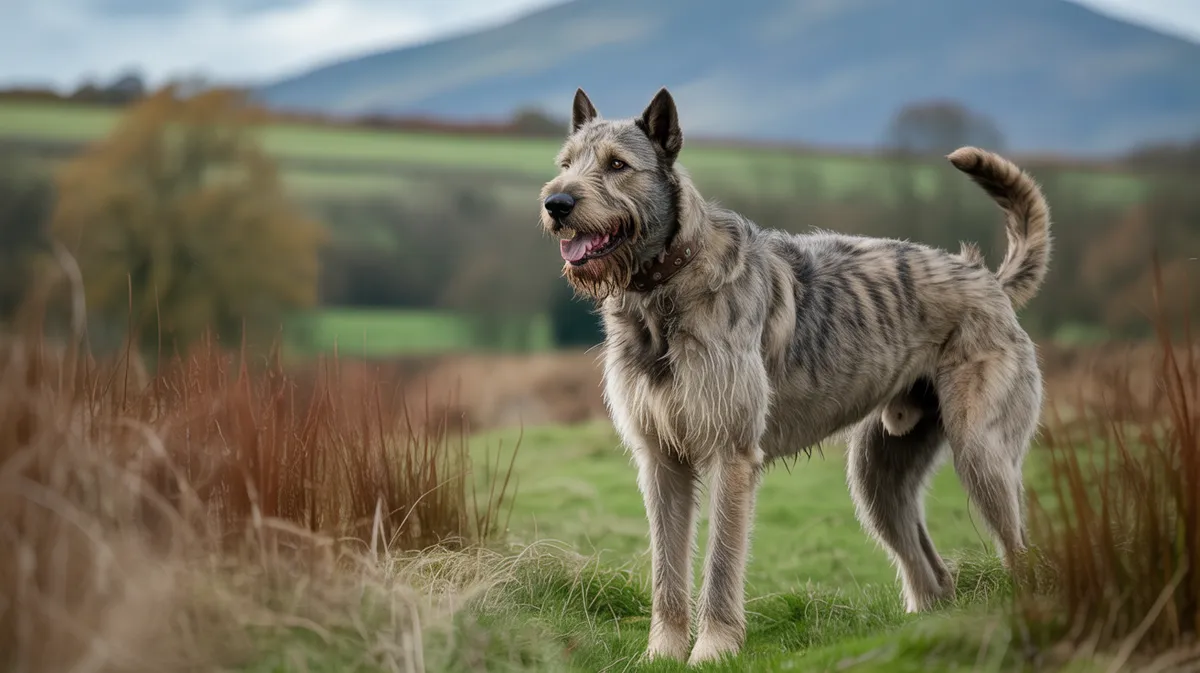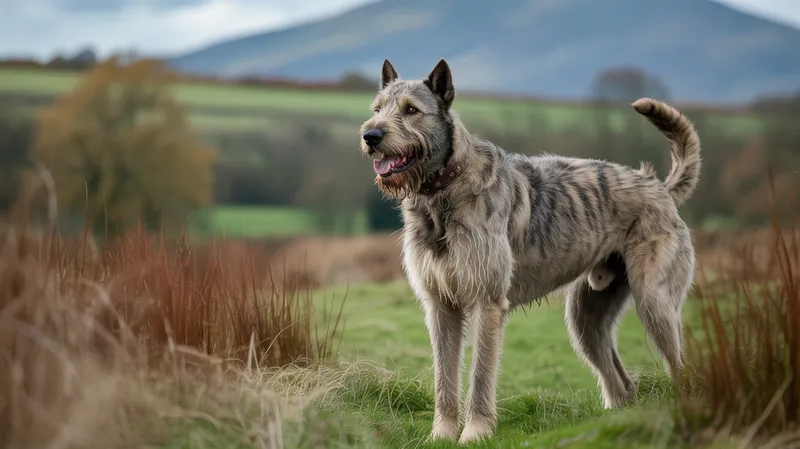
Irish Wolfhound
Canis lupus familiaris

Meet the Irish Wolfhound
The Irish Wolfhound is a giant breed of domestic dog, originally developed in Ireland for hunting wolves and large game. Recognized for its impressive height and gentle temperament, it is among the tallest of all dog breeds, often standing over 32 inches at the shoulder. Irish Wolfhounds are known for their wiry coat, long legs, and dignified appearance, making them both graceful and powerful. Despite their formidable size, they are renowned for being calm, loyal, and affectionate companions.
Classification
Mammal
Habitat
Domestic; historically open countryside and grasslands
Diet
Carnivore
Lifespan
6-10 years
Conservation
Least Concern
Weight
48–82 kg (105–180 lbs)
📖Fascinating Facts
Ancient Lineage
The Irish Wolfhound has a lineage that can be traced back to antiquity, with references found in ancient Irish laws and literature.
Record Height
Irish Wolfhounds are among the tallest dog breeds, with some individuals standing over 35 inches tall at the shoulder.
Royal Companions
Historically, Irish Wolfhounds were highly prized by kings and nobility, often exchanged as prestigious gifts.
📋Detailed Description
The Irish Wolfhound is one of the tallest and most imposing dog breeds, with males typically standing at least 32 inches (81 cm) at the shoulder and often reaching up to 34–35 inches (86–89 cm), while females are slightly smaller. Adult males commonly weigh between 140–180 lbs (64–82 kg), with females ranging from 115–140 lbs (52–64 kg). Their long, muscular limbs and deep chest contribute to their exceptional stride and endurance, traits originally selected for pursuing large game across open terrain. The breed's wiry, rough coat—usually gray, brindle, red, black, white, or fawn—offers protection against harsh weather and underbrush. Irish Wolfhounds possess a long, slightly arched neck, a broad head with a gentle expression, and small, rose-shaped ears. Despite their formidable size, they are renowned for their calm, dignified demeanor and gentle nature, especially with children and other animals. Their lifespan is relatively short for a dog, averaging 6–8 years, with some individuals reaching up to 10 years. Anatomically, they retain many features of ancient sighthounds, including keen eyesight, a deep thorax for increased lung capacity, and a flexible spine for speed. Socially, they are known for their loyalty and strong bonds with human families, often displaying a reserved but affectionate temperament.
💡 Did you know?
Irish Wolfhounds were so highly valued in ancient times that they were frequently given as gifts to royalty and other nobility across Europe.
🔬Research & Sources
Wikipedia Summary
The Irish Wolfhound is a breed of large sighthound that has, by its presence and substantial size, inspired literature, poetry and mythology. One of the largest of all breeds of dog, the breed is used by coursing hunters who have prized it for its ability to dispatch game caught by other, swifter sighthounds. In 1902, the Irish Wolfhound was declared the regimental mascot of the Irish Guards.
Last Modified: 5/22/2025
🎭Behavior & Social Structure
Irish Wolfhounds are generally quiet, gentle, and reserved, rarely displaying aggression. They are highly social animals, forming close attachments to their human families and often seeking companionship. Historically, they were used in packs for hunting large game such as wolves, deer, and boar, relying on their keen eyesight and stamina to track and pursue prey rather than scent. In modern settings, they are less active hunters but retain a strong prey drive and may chase moving objects. Their daily routines typically include periods of rest interspersed with moderate exercise; they require regular walks and opportunities to stretch their legs but are not as hyperactive as some other large breeds. Wolfhounds are sensitive to harsh discipline and respond best to gentle, consistent training. They are known to be tolerant of other dogs and pets if properly socialized. Despite their size, they often attempt to be close to their owners, sometimes behaving as 'gentle giants' who enjoy lounging indoors.
👶Reproduction & Life Cycle
Irish Wolfhounds reach sexual maturity relatively late compared to smaller breeds, with females typically coming into estrus for the first time between 18 and 24 months of age. The breed is known for small litter sizes, averaging 6–8 puppies, though litters of up to 12 have been reported. The gestation period is approximately 63 days. Females exhibit attentive maternal care, nursing and grooming their pups intensively during the first few weeks. Puppies grow rapidly, requiring careful management of nutrition and exercise to avoid developmental issues such as panosteitis or joint problems. Breeding is generally recommended only from health-tested adults to minimize the risk of hereditary conditions such as dilated cardiomyopathy and osteosarcoma, both of which are more prevalent in this breed. Responsible breeders often space litters and monitor for signs of reproductive or neonatal complications.
🛡️Adaptations & Survival
The Irish Wolfhound's most notable adaptation is its exceptional height and long legs, which enabled it to cover ground quickly and efficiently during hunts. Its deep chest and large heart support high aerobic capacity, essential for sustained pursuit. The wiry, double-layered coat offers protection from cold, wet climates and rough vegetation. Their keen vision, a hallmark of sighthounds, allows them to detect movement at great distances. Behaviorally, their calm temperament and high intelligence facilitate cooperation with humans and other dogs during complex hunts. Evolutionarily, the breed was shaped by selective breeding for strength, speed, and courage, allowing it to tackle formidable prey such as wolves and wild boar.
📚Research Sources
🎨Cultural Significance
The Irish Wolfhound has a storied place in Irish culture and mythology, often symbolizing nobility, strength, and loyalty. They appear in ancient Celtic legends as companions of warriors and kings, and were historically reserved for the nobility. The breed is referenced in Irish poetry and folklore, sometimes depicted as guardians or protectors. In 1902, the Irish Wolfhound was designated the regimental mascot of the Irish Guards, a British Army regiment, reflecting its national significance. Statues and imagery of the breed are common in Ireland, and it is considered a living symbol of the country's heritage. Historically, wolfhounds were also presented as diplomatic gifts to foreign rulers.
🔬Recent Research & Discoveries
Recent scientific studies have focused on the genetic health of the Irish Wolfhound, particularly in relation to cardiac and skeletal diseases. Advances in veterinary cardiology have led to improved screening protocols for dilated cardiomyopathy, a leading cause of mortality in the breed. Genetic research is ongoing to identify markers for osteosarcoma and other hereditary conditions. Studies on growth patterns have informed best practices for nutrition and exercise during puppyhood to minimize orthopedic problems. There is also interest in the breed's historical development, with DNA analysis revealing its complex ancestry, including contributions from ancient British and continental European sighthounds. Ongoing research by breed clubs and veterinary institutions aims to extend the breed's lifespan and improve overall health outcomes.
🎥Wildlife Videos

WOLF KILLERS - THE IRISH WOLFHOUND - Deadly or pet?
This week we meet another 'Wolf Killer' - The notorious Irish Wolfhound, responsible for the demise of the last Irish Wolf in the late ...
Animal Watch

The wolf EXTERMINATOR - Irish Wolfhound! A Murderer or a Pet?
The Wolfkiller is a notorious Irish wolfhound responsible for the extinction of wolves in Ireland. Is he really as enormous, strong, ...
It's interesting

ALL ABOUT IRISH WOLFHOUNDS: THE WORLD'S TALLEST DOG
Please support the Channel by checking out my affiliate links!!! Become a Dogumentary TV Channel member!!!
Dogumentary TV

WOLF KILLERS - THE IRISH WOLFHOUND PUPPY DOG - Dangerous?
Today we meet the puppies of the Giant Irish Wolfhound and find out everything in this guide to raising such a complex and ...
Animal Watch

Irish Wolfhound - Top 10 Facts
Irish Wolfhound is a historic sighthound dog breed from Ireland that has by its presence and substantial size inspired literature, ...
Dogs Wiz

Wolfhound VS Three Wolves. Wild Animal Battles Caught On Camera
The natural world is a tough place...wild animals are constantly battling it out whether its for food or territory. We have put together ...
THE MAGNUM
🌍Habitat Information
The Irish Wolfhound typically inhabits Domestic; historically open countryside and grasslands environments. Irish Wolfhounds have adapted to their environments with specialized features and behaviors.
Primary Habitat:
Domestic; historically open countryside and grasslands
More detailed habitat information will be available soon.
🛡️Conservation Status
The Irish Wolfhound is currently classified as Least Concern. Conservation efforts are crucial for preserving this species for future generations.
Common Threats:
- 🏠Habitat loss and fragmentation
- 🌡️Climate change impacts
- 🎯Hunting and poaching
- 🏭Human-wildlife conflict
⚠️Threats & Conservation Challenges
Today, the Irish Wolfhound faces several health challenges, primarily due to its large size and limited genetic diversity. The most significant threats include hereditary diseases such as dilated cardiomyopathy, osteosarcoma (bone cancer), gastric dilatation-volvulus (bloat), and hip dysplasia. The breed's short lifespan is a major concern among breeders and veterinarians. While not endangered, the population is relatively small, and responsible breeding practices are essential to maintain genetic health. Human impact is largely positive, as the breed is kept primarily as a companion animal, but irresponsible breeding and lack of awareness about health screening can exacerbate genetic issues. Conservation challenges focus on maintaining genetic diversity and reducing the incidence of inherited diseases.
🔬Scientific Classification
Scientific Name
Canis lupus familiaris
Classification Hierarchy
🔍 About Taxonomic Classification
Taxonomic classification is a hierarchical system used by scientists to classify and organize living organisms based on shared characteristics and evolutionary relationships.
The system moves from broad categories (Kingdom) to increasingly specific ones, with each animal's scientific name typically consisting of its Genus and species.
📝Community Notes
Share your observations and insights about the Irish Wolfhound with our community of wildlife enthusiasts.
Join Our Community
Sign in to share your observations and connect with fellow wildlife enthusiasts.
Sign In to ContributeNo community notes yet
Be the first to share your observations about the Irish Wolfhound!
Explore Irish Wolfhound
Select a tab above to learn more about this amazing animal.
📸Photo Gallery
No photos available for this animal yet.
🌟Discover More Wildlife
Continue your journey of discovery with more fascinating animals from our database
